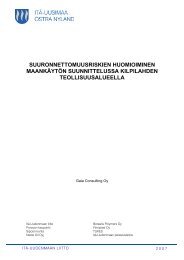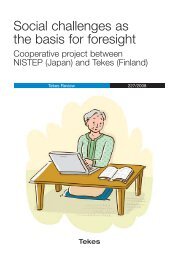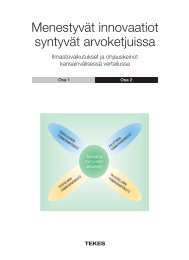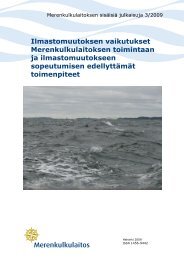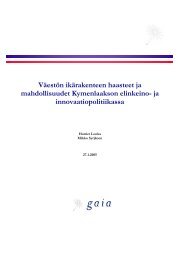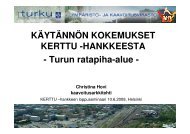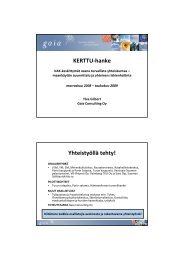Climate Risk Management in Finnish Development Cooperation - Gaia
Climate Risk Management in Finnish Development Cooperation - Gaia
Climate Risk Management in Finnish Development Cooperation - Gaia
You also want an ePaper? Increase the reach of your titles
YUMPU automatically turns print PDFs into web optimized ePapers that Google loves.
adaptation. The Intergovernmental Panel on <strong>Climate</strong> Change (IPCC) forecasts that by 2020, ra<strong>in</strong>-fed<br />
agricultural production <strong>in</strong> several African countries will decl<strong>in</strong>e by 50 percent. On the other hand, <strong>in</strong><br />
temperate regions, production may <strong>in</strong>crease due to warmer weather, allow<strong>in</strong>g the generation of a<br />
surplus. Such changes are likely to affect patterns of <strong>in</strong>ternational trade, with ga<strong>in</strong>s <strong>in</strong> some places<br />
and losses <strong>in</strong> others, <strong>in</strong> ways that are yet to be fully understood. In addition, the changes <strong>in</strong> energy<br />
prices as well as shape and structure of a post-2012 climate agreement could have considerable<br />
trade related implications for develop<strong>in</strong>g countries. As many poor countries depend on export<br />
revenues from few sectors, <strong>in</strong> particular agriculture, these economic implications need to be given<br />
careful consideration <strong>in</strong> trade and climate policy processes. 70<br />
Impacts on Ethiopia<br />
Ethiopia’s major <strong>in</strong>dustry is agriculture and animal husbandry (80 % of total employment).<br />
Government and services account for 12 % and <strong>in</strong>dustry and construction 8 %. Agriculture accounts<br />
for nearly half the country's GDP, 60% of its exports and 80% of total employment. Major trad<strong>in</strong>g<br />
partners are Saudi Arabia, Djibouti, US, Germany, Ch<strong>in</strong>a, Japan, Italy and India. 71 Coffee is critical to<br />
the Ethiopian economy with exports of some $350 million <strong>in</strong> 2006, but historically low prices have<br />
seen many farmers switch<strong>in</strong>g to other crops to supplement <strong>in</strong>come.<br />
The Ethiopian economy has done well <strong>in</strong> recent years, with GDP grow<strong>in</strong>g by 11.4% <strong>in</strong> 2006-07 and<br />
with the poverty headcount reduc<strong>in</strong>g from 44% <strong>in</strong> 1999/2000 to 39% <strong>in</strong> the recent 2004/05 survey.<br />
There have been important recent ga<strong>in</strong>s, especially <strong>in</strong> human development <strong>in</strong>dicators, transport, the<br />
<strong>in</strong>vestment climate, small town development, and the fight aga<strong>in</strong>st food <strong>in</strong>security. Pro-poor<br />
spend<strong>in</strong>g as a share of the budget has risen from 41% <strong>in</strong> 1997/98 to 62% <strong>in</strong> 2005/06. The Country<br />
Economic Memorandum 2006 (CEM) on Growth and Governance f<strong>in</strong>ds that important progress has<br />
been achieved <strong>in</strong> the past decade, largely driven by improved <strong>in</strong>stitutions, <strong>in</strong>clud<strong>in</strong>g at the regional<br />
and local levels, which have been able to deliver a scal<strong>in</strong>g-up o f services and <strong>in</strong>frastructure. 72<br />
However, significant challenges rema<strong>in</strong> to meet the Millennium <strong>Development</strong> Goals (MDGs),<br />
especially the goal of halv<strong>in</strong>g poverty by 2015, particularly consider<strong>in</strong>g that the recent progress is<br />
from a very low base and that the Ethiopian economy rema<strong>in</strong>s highly vulnerable to climate shocks.<br />
Inflation was high (18% dur<strong>in</strong>g 2006/07), with associated <strong>in</strong>creases <strong>in</strong> food prices. Imports have been<br />
grow<strong>in</strong>g faster than exports, enlarg<strong>in</strong>g the trade deficit. However, public expenditure has been well<br />
managed <strong>in</strong> recent years and the fiscal deficit has reduced from 4.6% of GDP <strong>in</strong> 2005/06 to 3.6% of<br />
GDP <strong>in</strong> 2006/07. 73<br />
The Ethiopian agricultural sector is dom<strong>in</strong>ated by small-scale farmers who employ largely ra<strong>in</strong>-fed<br />
and traditional practices – a state which renders Ethiopia highly vulnerable to climate variability, and<br />
thus to climate change. An <strong>in</strong>dication of the impact that climate variability and climate change has<br />
70 ICTSD 2008: xv<br />
71 http://www.fco.gov.uk/en/about-the-fco/country-profiles/sub-saharan-africa/ethiopia?profile=economy&pg=2<br />
72 World Bank (2008:9)<br />
73 World Bank (2008:9)<br />
43



